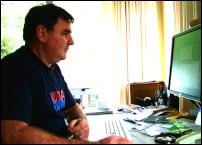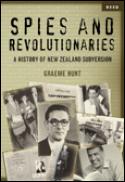Graeme Hunt's Book on New Zealand Spies and Revolutionaries – Chapter Eleven: The age of terror
Scoop is serializing the first 1000 words of each chapter of author Graeme Hunt's latest book: Spies And Revolutionaries – A History of New Zealand Subversion. Click here for Chapter Eleven: The age of terror
 The history of New Zealand's intelligence agencies and
those it has spied on have been laid bare in a book by
Auckland-based journalist, author, and historian Graeme
Hunt.
The history of New Zealand's intelligence agencies and
those it has spied on have been laid bare in a book by
Auckland-based journalist, author, and historian Graeme
Hunt.
Spies And Revolutionaries – A History of New Zealand Subversion details how several prominent New Zealanders, all of whom are dead, spied for the former Soviet Union during the Cold War. Accusations and suspicions are laid bare before files and information that has never before been made public. This book will clearly recharge debate as to whether Dr Bill Sutch, diplomat Paddy Costello, and public servant Ian Milner were spies acting against New Zealand's national interest.
CHAPTER ELEVEN: The age of terror
 Nicky Hager’s first book, Secret Power, was a
godsend for the left. Published in 1996, five years after
the demise of the Soviet Union and the official end of the
Cold War, it gave elderly communists something to cheer
about long after communism had lost any shred of decency,
and it inspired a new wave of activism among dissidents too
young to remember Stalin or Khrushchev. Whereas New Zealand
communists had essentially been agents of a foreign power
–– Russia, China or, for a handful, Albania –– the
new Kiwi dissidents became agents of a multitude of global
causes including indigenous rights, feminism,
environmentalism, anti-free trade and ‘peace’.
Nicky Hager’s first book, Secret Power, was a
godsend for the left. Published in 1996, five years after
the demise of the Soviet Union and the official end of the
Cold War, it gave elderly communists something to cheer
about long after communism had lost any shred of decency,
and it inspired a new wave of activism among dissidents too
young to remember Stalin or Khrushchev. Whereas New Zealand
communists had essentially been agents of a foreign power
–– Russia, China or, for a handful, Albania –– the
new Kiwi dissidents became agents of a multitude of global
causes including indigenous rights, feminism,
environmentalism, anti-free trade and ‘peace’.
The peace movement was the oldest left-wing protest grouping in New Zealand, dating from a socialist campaign against compulsory military training launched in 1909, and by far the most enduring. From the Russian Revolution until the early 1960s it was the domain of communists and Christian pacifists. During the Vietnam War it gained respectability and grew to include many hitherto non-politicised New Zealanders unconvinced by the veracity of the United States’ domino theory about the spread of communism. The movement became the genesis of New Zealand’s anti-nuclear campaign and, later on, the critic of Western military involvement in Afghanistan and Iraq. It did not hesitate to fan unbridled anti-Americanism in the process.
Most New Zealanders were shocked by the al-Qaeda attacks on the World Trade Center, New York City, and the Pentagon on 11 September 2001 but few understood the American psyche on security matters let alone the United States’ role as the world’s only superpower. The Americans, for their part, demonised al-Qaeda as they had the Soviet Union for the three previous generations. In return, al-Qaeda became the demon they most feared –– something British spywriter John le Carré observed wryly in an interview with the BBC World Book Club in late 2006.
Secret Power,
written before
al-Qaeda became a household name, exposed
New Zealand’s role in the international intelligence
network through the Government Communications Security
Bureau and also the workings of the Echelon worldwide
signals intelligence and analysis system.
The Government Communi-cations Security Bureau was established secretly by National Prime Minister Rob Muldoon in 1977. As Hager notes in his book, it was 1984 before Parliament learned officially that the bureau existed and only then because veteran peace campaigner Owen Wilkes2 had publicised the existence of a previously secret radio eavesdropping station at Tangimoana Beach in the Manawatu. That base, run by the bureau since 1982, was linked to the Anglo–American intelligence network that had been formalised in the 1948 UKUSA Security Agreement. Wilkes’ disclosure was five years before the bureau opened a second base, a satellite communications interception station, at Waihopai, near Blenheim.
Hager’s well-researched book made much of the covert nature of global intelligence-gathering and New Zealand’s supposed subordination to the United States on intelligence matters. It reactivated the campaign against so-called ‘foreign’ spy bases in New Zealand, turning Hager, a Wellington-based peace researcher, into a public figure. It also contributed to the Labour government’s decision in 2000 to put the bureau on a legislative footing3 as the National government had done with the Security Intelligence Service in 1969.
But for all the gnashing of (left-wing) teeth, the Government Communications Security Bureau was doing a job that had been handled previously by various agencies, including the New Zealand Combined Signals Organisation, formed in 1955. The bureau had coped remarkably well, given the political hurdles that arose when New Zealand declared itself nuclear free in 1987.
Bureau director Dr Warren Tucker (later the SIS director of security) issued a rare public statement in January 2006 to deny peace campaigners’ allegations about his organisation. It followed a Sunday Star–Times story covering the disclosure of the bureau’s 1985/86 annual report among the papers of the late former Labour prime minister, David Lange.
Tucker rejected claims that the bureau had demonstrated greater loyalty to the UKUSA Security Agreement than to New Zealand, that it had kept the minister in charge of the bureau (the prime minister) ‘in the dark’ over its work and that it had allowed its stations at Tangimoana and Waihopai to operate as US bases. Tucker went on:
The [bureau’s] twin roles are spelled out in the [Government Communications Security Bureau] Act 2003. These are –– first to collect and report secret foreign intelligence derived from the inception and analysis of foreign communications, on matters of importance to the New Zealand Government. Secondly, the [bureau] provides the tools and advice necessary to ensure that the communications systems and computer networks used for official and government business and for critical infrastructure are properly protected from tempering and from unauthorised access … For the bureau to do its work effectively it must operate in secret. In particular, details of its targets and its operations must not be publicly confirmed. Even informed speculation in the media can be very damaging …
This did not silence the critics –– conspiracy theories are more powerful than facts –– but it reflected the start of a charm offensive to make the bureau a little more acceptable to ordinary New Zealanders. In security terms, however, the left’s anti-base, anti-American and anti-SIS campaigns were minor compared with the challenge of global terrorism facing the bureau and the SIS.
In August 2000 the New Zealand Herald reported that a group of Afghan refugees in Auckland had set up a ‘command centre’ and were planning to blow up the Lucas Heights nuclear reactor in Sydney –– Australia’s only nuclear reactor –– during the Sydney Olympic Games. New Zealand police were said to have stumbled on the terrorist plans during a probe into an immigration racket. But the Australian government did not accept the threat as legitimate and denied there was a link between the Auckland group and the Saudi-born terrorist, Osama bin Laden. No one was arrested on terrorism offences but four people were detained on passport violations.
See Also:
and Revolutionaries, Chapter Seven: Trinity's
traitor
& Revolutionaries – Chapter Six: Empire strike
Back
and Revolutionaries – Chapter Five: Red wreckers and
fellow travellers
and Revolutionaries – Chapter Four: Lenin's Lieutenants
and Revolutionaries – Chapter Three: Karl Marx's
legacy
Spies and Revolutionaries - Chapter Two: French, Russians
and Fenians
and Revolutionaries - Chapter One: Murder in a country
churchyard
Scoop is serializing the first 1000 words of each chapter of author Graeme Hunt's latest book: Spies And Revolutionaries – A History of New Zealand Subversion.
SRP: $29.99
ISBN:
9780790011400
340p, includes index, black and white
photos
Reed Publishing (NZ) Ltd www.reed.co.nz
Release: August 6 2007
For more, see… Reed Publishers, Spies And
Revolutionaries



 Eugene Doyle: The Fall Of Saigon 1975 - Fifty Years Of Repeating What Was Forgotten
Eugene Doyle: The Fall Of Saigon 1975 - Fifty Years Of Repeating What Was Forgotten Peter Dunne: Dunne's Weekly - Trump's Tariffs Still Pose Risks For New Zealand
Peter Dunne: Dunne's Weekly - Trump's Tariffs Still Pose Risks For New Zealand Keith Rankin: Barbecued Hamburgers And Churchill's Bestie
Keith Rankin: Barbecued Hamburgers And Churchill's Bestie Gordon Campbell: On Why The US Stands To Lose The Tariff Wars
Gordon Campbell: On Why The US Stands To Lose The Tariff Wars Eugene Doyle: Before It’s Too Late - Reimagine New Zealand’s Military Future
Eugene Doyle: Before It’s Too Late - Reimagine New Zealand’s Military Future  Binoy Kampmark: Gender Stunts In Space - Blue Origin’s Female Celebrity Envoys
Binoy Kampmark: Gender Stunts In Space - Blue Origin’s Female Celebrity Envoys